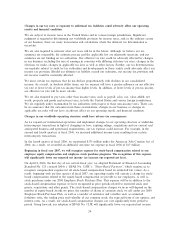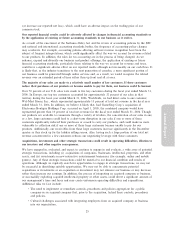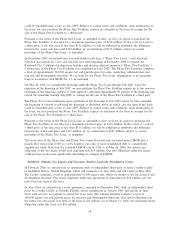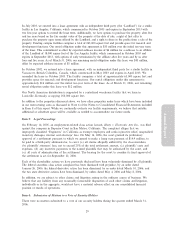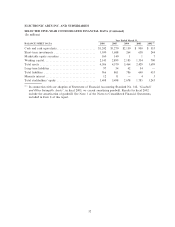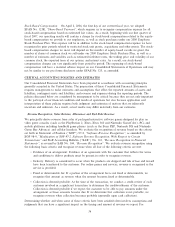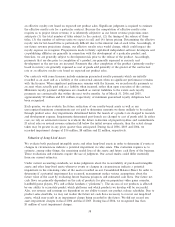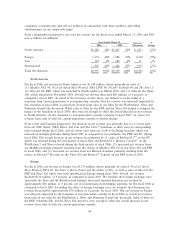Electronic Arts 2006 Annual Report Download - page 106
Download and view the complete annual report
Please find page 106 of the 2006 Electronic Arts annual report below. You can navigate through the pages in the report by either clicking on the pages listed below, or by using the keyword search tool below to find specific information within the annual report.and eventually reach the end of their commercial life cycle and next-generation consoles are introduced
into the market, sales of video games for current-generation consoles will continue to decline as consumers
replace their current-generation consoles with next-generation consoles, or defer game software purchases
until they are able to purchase a next-generation console. This pattern is referred to in our industry as a
transition to next-generation consoles. During this transition, we intend to continue to develop new titles
for current-generation video game consoles while we also continue to make signiÑcant investments in the
development of products for next-generation consoles. We expect the average selling prices and the
number of units of our titles for current-generation consoles to continue to decline as more value-oriented
consumers purchase current-generation consoles, a greater number of competitive titles are published at
reduced price points, and consumers defer purchases in anticipation of next-generation consoles. We expect
our gross margins to be negatively impacted by (1) a decrease in average selling prices of titles for
current-generation platforms, (2) higher license royalty rates, and (3) amortization of our newly-acquired
intangible assets.
We have incurred, and expect to continue to incur, higher costs during this transition to next-generation
consoles. Moreover, we expect development costs for next-generation video games to be greater on a per-
title basis than development costs for current-generation video games. We also expect our operating
expenses to increase for the Ñscal year ending March 31, 2007 as compared to prior Ñscal years, primarily
as a result of (1) the recognition of stock-based compensation due to our adoption of Statement of
Financial Accounting Standard No. 123 (revised 2004) (""SFAS No. 123R''), and (2) higher expenditures
for research and development due to our investment in next-generation consoles, online and mobile
platforms. As we move through the life cycle of current-generation consoles, we will continue to devote
signiÑcant resources to the development of current-generation titles while at the same time continuing to
invest heavily in tools, technologies and titles for the next generation of platforms and technology. We
expect our operating results to continue to be volatile and diÇcult to predict, which could cause our stock
price to Öuctuate signiÑcantly.
Expansion of Mobile Platforms. Advances in mobile technology have resulted in a variety of new and
evolving platforms for on-the-go interactive entertainment that appeal to a broader demographic of
consumers. Our eÅorts to capitalize on the growth in mobile interactive entertainment are focused in two
broad areas Ì packaged goods games for handheld game systems and downloadable games for cellular
handsets.
We have developed and published games for a variety of handheld platforms, including the Nintendo
Gameboy and Gameboy Advance, for several years. The introductions of the Sony PSP and the Nintendo
DS, with their richer graphics, deeper gameplay, and online functionality, provide a richer mobile gaming
experience to consumers. As a result, we have seen, and expect to continue to see, an increase in demand
for our games for handheld platforms. In Ñscal 2006, our net revenue from handheld platforms increased
217 percent over Ñscal 2005 to $374 million.
As cellular handsets become more-and-more commonplace and wireless technology advances to include
high-resolution color displays, increased processing power and improved audio capabilities, we expect sales
of games for cellular handsets to become an increasingly important part of our business worldwide. To
accelerate our position in this growing segment, in February 2006, we acquired JAMDAT Mobile Inc.
(""JAMDAT''), a global publisher of wireless games and other wireless entertainment applications. As a
result of this acquisition, in Ñscal 2007, we expect our net revenue from games for cellular handsets to
increase signiÑcantly from $19 million in Ñscal 2006. Likewise, the acquisition, along with the additional
investment required to grow this portion of our business globally, will result in increased development and
operating expenses.
As mobile technology continues to evolve and the installed base of both handheld game systems and
cellular phones expands, we expect that sales of our titles for mobile platforms Ì for both handhelds and
cellular handsets Ì will become an increasingly important part of our business.
Investment in Online. Today, we generate net revenue from a variety of online products and services,
including casual games and downloadable content marketed under our Pogo brand, persistent state world
34


